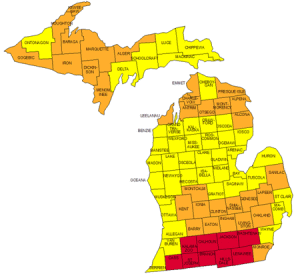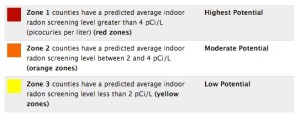It soon became evident that radon could, indeed, be a problem in some Michigan homes, and in an effort to better characterize the health risk in this state, MDPH, with the assistance of the U.S. Environmental Protection Agency (EPA) and Michigan’s local health departments (LHDs), initiated a statewide residential indoor radon survey. Conducted during the 1987-88 winter heating season with all but four of the state’s 83 counties participating, the survey found that approximately 12 percent of the homes in this state (nearly one in eight) would have radon screening levels greater than 4 picocuries per liter (pCi/l) of air (4 pCi/l is the recommended action guideline set by EPA). In some counties, as many as 40-45 percent (or more) of the homes would have screening levels above the 4 pCi/l guideline.
Later, EPA worked with the U.S. Geological Survey and the state radon programs to develop a “map of zones” to help identify areas of the U.S. with the potential for elevated indoor radon levels. Counties were ranked into one of three categories (Zone 1, Zone 2, or Zone 3, with “1” being higher potential and “3” being lower potential) based on indoor radon measurements (i.e., data from the 1987-88 residential radon survey), geology, aerial radioactivity, soil permeability, and foundation type.
Michigan Radon Map
This Map of Zones was developed to assist national, state, and local organizations in targeting their resources for outreach and education, as well as to assist building code officials in deciding whether radon-resistant features should be incorporated into new construction. These maps are NOT intended to be used to determine if a home in a given zone should be tested for radon. Homes with elevated levels of radon have been found in all three zones. All homes should be tested regardless of geographic location.
The truth is, any home could have a radon problem, whether it’s in an area with a high radon potential or an area with a low radon potential, or whether it’s old or new, energy-efficient or drafty, built on a slab or built over a basement or crawlspace. Because it’s a tasteless, odorless, colorless gas, there are no physical signs that will alert you to the presence of radon in a home. (It doesn’t smell bad, there is no discoloration of the foundation, there are no visible traces of the gas, etc.) And, there are no warning symptoms to let you know you’re being exposed. (It doesn’t cause headaches, nausea, fatigue, skin rashes, etc.) The only way to know whether your home has a problem–or whether you are at risk–is to test!
While your neighbor’s test results may provide some indication of the potential for a problem in your home, radon levels can vary significantly from lot to lot and home to home. Don’t rely on your neighbor’s test results to determine your risk. Test your own home and be certain!
*NOTE: In June of 1989 Governor James Blanchard designated the Michigan Department of Public Health (MDPH) the state agency with primary responsibility for the radon program. In April 1996, an Executive Order issued by Governor John Engler transferred the responsibility to the Michigan Department of Environmental Quality.


